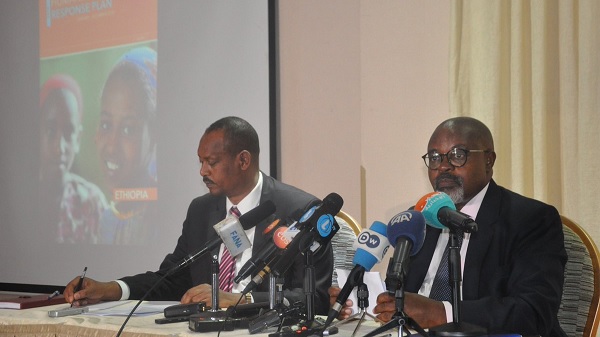
During the launching of the 2019 Ethiopia Humanitarian Response Plan, it was reported that US$ 1.3 billion required to address food and non-food needs of 8.3 million people who are affected by violence and drought.
ADDIS ABABA (OCHA)–Commissioner Mitiku Kassa of the National Disaster Risk Management Commission and Mr. Aeneas Chuma, the United Nations Resident and Humanitarian Coordinator officially launched the joint Government and humanitarian partners’ Ethiopia Humanitarian Response Plan for 2019 on Thursday (March 7), in the presence of Government, humanitarian partners and donor representatives.
The Ethiopia Humanitarian Response Plan lays out prioritized multi-sector humanitarian needs in 2019 targeting 8.3 million people with emergency food and non-food assistance amounting to US$ 1.314 billion. Some 4.4 million people are targeted for nutrition support, including 609,961 children under five years of age targeted for the treatment of severe acute malnutrition (SAM). In addition, 2.7 million displaced people and returnees will benefit from emergency shelter and NFI assistance, while millions will receive emergency health, water, education, protection and agriculture support until the end of the year. The needs are identified through a thorough analysis of the overall humanitarian needs of the country, through the Humanitarian Needs Overview.
“As I speak today, 8 million people require emergency food or cash assistance, of whom 46 per cent are in Oromia, 22 per cent in Somali, 12 per cent in Amhara, 10 per cent in SNNP, 4 per cent each in Tigray and Afar regions. The remaining beneficiaries are in Gambela, Benishangul Gumuz, Harari and Dire Dawa,” said Commissioner Mitiku Kassa.
RELATED: Sweden contributes US$ 3.2 million to UNICEF Ethiopia’s humanitarian appeal for children
Ethiopia was spared significant climate-related calamities last year, but spikes in conflict-induced displacements in 2018, which led to a near doubling of internally displaced population, contributed to high humanitarian response needs in 2019.
“We acknowledge and appreciate the Government’s leadership in addressing the needs of people affected by crisis across the country. We also recognize the daunting challenges ahead and the urgent need to scaleup assistance,” said Mr. Aeneas Chuma. “International humanitarian partners are committed to continue to closely work with Government counterparts and to provide timely assistance to affected populations based on needs. This is the humanitarian imperative we abide by, and a testament of our commitment and partnership with the people and Government of Ethiopia,” he added.
Thanks to the leadership of the Government and the generous support from donors and friends of Ethiopia, the multi-sector life-saving assistance has helped mitigate the worst effects of the humanitarian crisis in 2018. The Government has allocated US$342 million and donors have contributed US$595 million for the 2018 response.
“I call upon the international community to continue their generosity and to provide the required resources in time to help alleviate the suffering of the most vulnerable people,” said Mr. Chuma. Without urgent additional funding, most life-saving operations, including nutrition interventions, will cease beyond March 2019.
“Ethiopia is at a transition,” added Commissioner Mitiku, “This is a time of hope and ample opportunity for the country and the region as a whole. Some of the humanitarian challenges from conflict hazard we have been seeing in recent months, and which is affecting many people are an unfortunate effect of transitional periods. But the Government of Ethiopia is strongly committed to address this transitional challenge, and we thank our partners and friends, who stood by us at this critical time,” he concluded.
Source: OCHA
